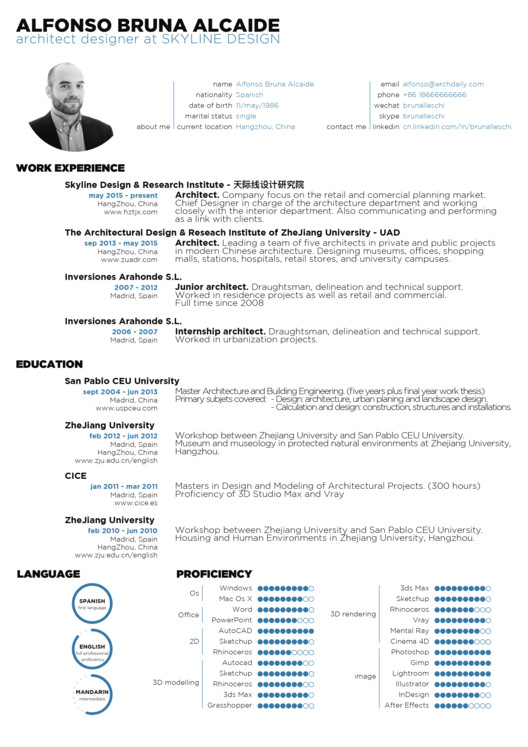In the end, however, we based our selection on the CVs that stood out from the hundreds of submissions. We looked for CVs that transmitted the personality of the designer, their ability to communicate visually and verbally, and perhaps, the most intangible criteria for evaluation—the "creativity" of the CV. The documents below represent the diversity of styles and formats that just might land you a job at your dream firm.
But before we get started, we thought we would take this opportunity to present our top tips for designing your own résumé:

About the design: "How could a résumé describe a candidate and be simple and clear at the same time? We have to make a choice. Mine is to use a very simple layout, working only with different heights and weights of one font. The résumé is only one part of the presentation: a QR code leads to a complete portfolio on the web. We live in a connected world. I think also the résumé has to express it." - Andrea
Why we like it: While simple, we love the impact of Andrea's font choice and size, and the QR code is a great addition—it operates as both a zeitgeisty aesthetic addition and a functional way to communicate more about yourself.
About the design: "This design was intended to be straightforward which captures the designer profile in one shot, through the use of pairing fonts to make each sections individual, yet harmonize with the entire flow. The color use is to allow the employee or interviewer to understand the interviewee strengths and weaknesses at a glance." - Bernadette
Why we like it: Alfonso's design cleverly uses a variety of different text formats, with text size, weight, and color, all contributing to organizing information effectively. Plus, we can't fault the color scheme.
But before we get started, we thought we would take this opportunity to present our top tips for designing your own résumé:
- File Size: If you're a decent designer/architect, then you should know better than to send a file that's over 5MB.
- Typos & Mistakes: If the language of your résumé isn't your native language, turn to online communities or ask someone to proofread your résumé.
- The most creative résumés stand out not only visually, but because they are not difficult to read or understand. Many submissions were elaborate visual mazes of information that weren't aesthetically unpleasing, but utterly impenetrable when it came to understanding key information about the applicant.
- If someone asks you for a CV or résumé, they are not asking you to send a portfolio. However, if you're submitting your CV electronically, it's not a bad idea to include a link to your portfolio!
- Don't copy: It's ok to be inspired by certain designs, but straight-up copying isn't just wrong, it probably won't be the best representation of who you are and the design work you are capable of. If making an unconventional résumé doesn't come naturally, it's probably best to stick to a standard, more classic CV.
- The ArchDaily editors are still on the fence about the trend of "rating yourself" in different areas of expertise. It seems very subjective and less informative than it is visually appealing. The jury's still out on this one.

Why we like it: While simple, we love the impact of Andrea's font choice and size, and the QR code is a great addition—it operates as both a zeitgeisty aesthetic addition and a functional way to communicate more about yourself.
About the design: "This design was intended to be straightforward which captures the designer profile in one shot, through the use of pairing fonts to make each sections individual, yet harmonize with the entire flow. The color use is to allow the employee or interviewer to understand the interviewee strengths and weaknesses at a glance." - Bernadette
Why we like it: On an otherwise understated design layout, the presentation of the skills really stands out here, with the colorful icons grabbing the reader's attention. As mentioned above, we're not sure about the practice of rating your own skills numerically, but if you must do so this is the way to show it off.
About the design: "minimalism" - idan
About the design: "minimalism" - idan
Why we like it: Well, I suppose we couldn't have said it better ourselves. This design speaks to the architect's innate minimalistic taste.
About the design: "Love what you create, Create what you love, Inspire the world" - Turgut
About the design: "Love what you create, Create what you love, Inspire the world" - Turgut
Why we like it: Though deceptively simple in layout, this design is undeniably striking, thanks to the well-chosen image which grounds the entire page—while also providing a simple color scheme to highlight the skills section.
About the design: "I wanted to make something brief and eye pleasant with only a small touch of blue to stand out." - Alfonso
About the design: "I wanted to make something brief and eye pleasant with only a small touch of blue to stand out." - Alfonso
Why we like it: Alfonso's design cleverly uses a variety of different text formats, with text size, weight, and color, all contributing to organizing information effectively. Plus, we can't fault the color scheme.














No comments:
Post a Comment